Key Points:
- NZDUSD remained stable at $0.6221
- U.S. jobs data expected to determine the likelihood of a 50-basis-point Fed rate cut in September.
- The Reserve Bank of New Zealand is forecasted to cut rates again in October, but improved confidence reduces urgency for an outsized cut.
The New Zealand dollar (Symbol: NZDUSD) remained stable at $0.6221 after a week of minor losses.

Picture: NZDUSD price steady as US jobs data looms, as observed on the VT Markets app.
The markets are now focusing on the upcoming U.S. jobs data to gain insights into recession risks and the potential pace of Federal Reserve rate cuts. It is anticipated that there will be a possible slowdown in U.S. job creation, with the U.S. payroll report expected to reveal weaker numbers.
Given the recent trend of softer data, there is a growing expectation for an aggressive interest rate cut by the Federal Reserve. A disappointing jobs figure would fuel speculation for a 50-basis-point rate cut on September 18, up from the 25-bps cut that markets have fully priced in. This could result in a weaker U.S. dollar, providing short-term support for the NZDUSD currency pair.
On the other hand, the Reserve Bank of New Zealand (RBNZ) is expected to continue its easing cycle. Having already lowered its cash rate to 5.25%, the central bank is projected to cut rates again in October. Market sentiment shows a 41% probability of a 50-basis-point cut. However, the RBNZ has hinted that the urgency for an outsized rate cut has diminished due to improved consumer and business confidence.
Impact of interest rate differentials
The contrasting monetary policies between the Federal Reserve and the RBNZ will likely shape the trajectory of the New Zealand dollar. While the U.S. is expected to cut rates more aggressively, easing inflationary pressures and a weakening labour market, New Zealand’s economy appears more resilient, limiting the extent of future rate cuts.
Market outlook for NZDUSD
The recent consolidation suggests that the Kiwi dollar may experience volatility depending on how the upcoming data unfolds. Traders may capitalise on price swings driven by market reactions to U.S. payrolls.
Related article: Simple strategies for trading on news
If the report disappoints and triggers expectations for a larger rate cut, we could see the kiwi rise further against a weaker U.S. dollar. Conversely, stronger-than-expected U.S. data could push the NZD lower, as the Fed may opt for a more measured pace in cutting rates. In addition, monitoring local economic indicators such as upcoming inflation data and retail sales figures in New Zealand will help traders gauge the RBNZ’s next move.









